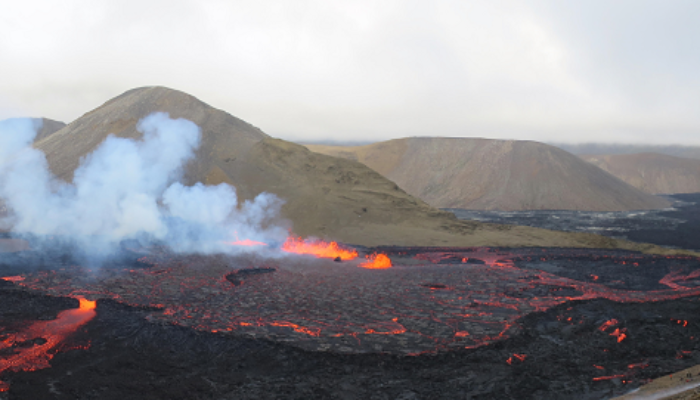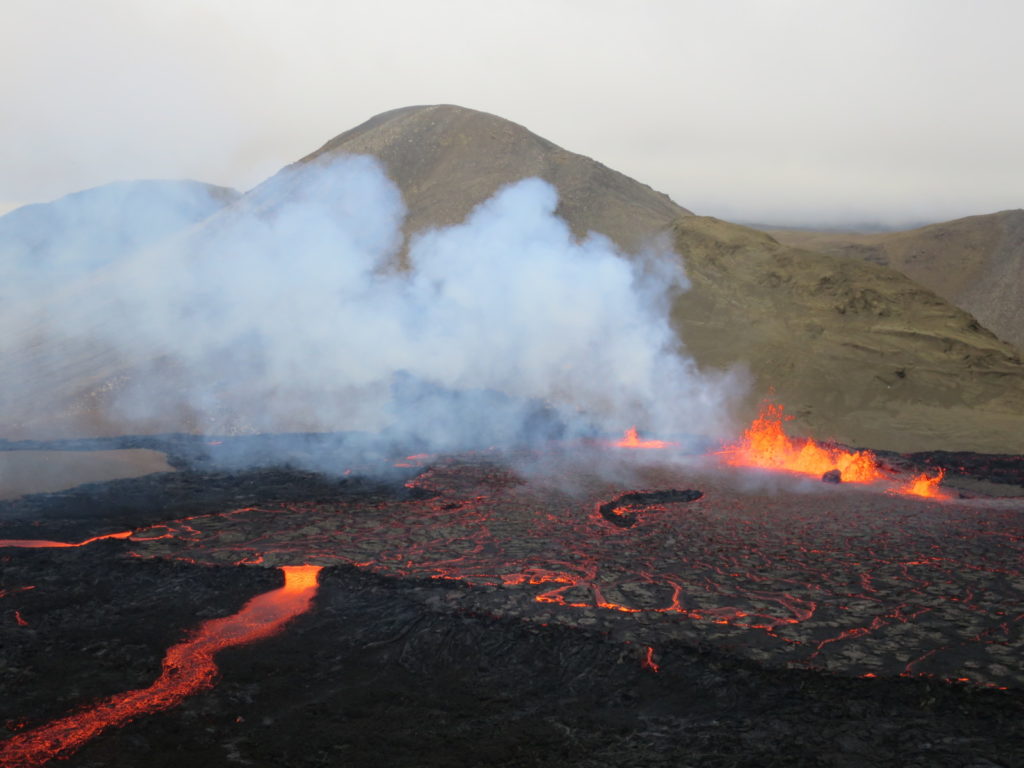
The Icelandic eruptions of 2021 and 2022 originated in the Reykjanes peninsula, characterized by the Krýsuvík-Trölladyngja system, one of the five volcanic systems present along the peninsula. This peninsula is a leaky transform fault, characterized by episodic rifts and associated volcanism. The last two years have brought about some of the most momentous volcanic eruptions in recent history. The Fagradalsfjall fissure, in particular, has been incredibly active, with two eruptions in the last two years. The 2021 eruption lasted for a six months, from March 19th to September 18th. And the activity of 2022 it developed throughout the month of August. This recent period of volcanism follows 800 years of dormancy.
The uniqueness of the two eruptions mentioned have led to several scientists taking an interest in studying these events. In particular, a research group made up of volcanologists from the Nordic Volcanological Center – Institute of Earth Sciences of the University of Iceland – Reykjavík, was involved in studying and interpreting the data relating to the seismic activity and in the study of the chemistry of lavas (https://earthice.hi.is/). Today, we can begin to say that the 2022 eruption was more “linear” over time and obviously shorter, while the 2021 eruption was longer and divided into more eruptive episodes.
One of the peculiarities of the 2021 eruption, highlighted in one of the latest articles published in the journal Nature, is the development of seismic activity. Through a careful monitoring system it has been seen that the seismic activity begins in this area in December 2019 and continues until September 2021 with the end of the eruption. The peculiarity related to the 2021 eruption and the difference with respect to the seismicity present during the 2022 eruption, is given by the fact that the seismic activity increases in the 3 weeks prior to the eruption, with earthquakes reaching a magnitude of 5.6, but then drastically decrease in the days before the eruption.

Image relating to the Fagradalsfjall eruption in 2021. Photo recovered from https://www.theatlantic.com/photo/2021/03/photos-up-close-with-icelands-fagradalsfjall-volcano/618471/
This drop in intensity is considered a peculiarity as soil displacement rates and the number of earthquakes usually increase in the moments just before eruptions as magma makes its way to the surface. The magma chamber for this eruption is located approximately 8 km below the surface, with a length of 9km. Volcanologists have determined that deformation and seismic activity are closely related to the speed at which the magma is flowing; as the magma is forced upwards to reach the magma chamber, it encounters rocks that offer more resistance along the way and as a result, seismic activity increases. However, once the tectonic stress is released along the magma chamber, the magma arrives close to the surface, starting the eruption without significant seismic activity so as to be poorly visible in the signals. And that’s why, in the moments just before the eruption, in this case there seems to be a significant decrease in seismicity.

Lava products from the 2021 eruption of Fragadalsfjall. Photos of the area in the period between the eruption of 2021 and that of 2022. Photo by Mirko Messina.
A totally different behavior occurs during the eruption of the Fagradalsfjall in August 2022. From mid-June significant deformations and swellings of the ground up to 3 cm are identified and, starting from July 30, a considerable seismic swarm develops, in some cases with a magnitude greater than 3-5, affecting the area north-east of Fragadalsfjall and a few kilometers north of Geldingadalir, with the hypocenters at a depth of about 2-5 km. The seismic activity in this case continues without stopping from mid-June until the end of the eruption and 2700 earthquakes are recorded the day before the eruption.
The other key connection between the 2021 and 2022 eruptions of Fragadalsfjall is the magma. The products that came out during the second eruption are tholeiitic basalts with compositions that are almost exactly the same as those from the end of the 2021 eruption. According to researchers from the University of Iceland, the magma for the 2022 eruption was already present in the conduit and had to be precisely from the final stages of the 2021 eruption. Over the months this magma would have cooled and crystallized and, with the arrival of new magma from deeper reservoirs, and therefore different pressure and temperature conditions, would have started the eruption. It can therefore be said that the first products erupted in 2022 are connected with the evolutionary history of the products erupted in 2021, which is to be considered anything but boring.
In fact, the first geochemical analyzes on the first volcanic products of 2021 identified a lava rich in magnesium. However, researchers have found that the composition of the magma changes during different phases of an eruption, from one lava of superficial origin to another of deep derivation. Furthermore, they have found that there is a total homogenization of the magmatic melt before it is released to the surface. This is the first example that confirms what scientists have been saying for some time: that different magmas can mix deep in magma systems before an eruption.
These last two eruptions with their seismic activity and with the geochemistry of the lavas, allow us to underline how much the study of the precursors and of the volcanic eruptions themselves, is fundamental to understand the potential risks, to reduce the impact on people and infrastructures and to make us more and more connected to our Planet, up to the center of the Earth.
Sources and Bibliography
Halldórsson, S. A., Marshall, E. W., Caracciolo, A., Matthews, S., Bali, E., Rasmussen, M. B., Ranta, E., Robin, J. G., Guðfinnsson, G. H., Sigmarsson, O., Maclennan, J., Jackson, M. G., Whitehouse, M. J., Jeon, H., van der Meer, Q. H. A., Mibei, G. K., Kalliokoski, M. H., Repczynska, M. M., Rúnarsdóttir, R. H., … Stefánsson, A. (2022). Rapid shifting of a deep magmatic source at Fagradalsfjall volcano, Iceland. Nature, 609(7927), 529–534. https://doi.org/10.1038/s41586-022-04981-x
Sigmundsson, F., Parks, M., Hooper, A., Geirsson, H., Vogfjörd, K. S., Drouin, V., Ófeigsson, B. G., Hreinsdóttir, S., Hjaltadóttir, S., Jónsdóttir, K., Einarsson, P., Barsotti, S., Horálek, J., & Ágústsdóttir, T. (2022). Deformation and seismicity decline before the 2021 Fagradalsfjall eruption. Nature, 609(7927), 523–528. https://doi.org/10.1038/s41586-022-05083-4
https://volcano.si.edu/volcano.cfm?vn=371032
https://en.vedur.is/about-imo/news/fagradalsfjall-eruption-unusual-in-many-ways-compared-to-other-eruptions
https://guidetoiceland.is/nature-info/complete-guide-to-the-2022-volcanic-eruption-of-fagradalsfjall-volcano
https://www.aivulc.it/it/archivio-notizie/
https://earthice.hi.is/



Barbara Cristina
Wow bravaaaaaa
Anna Maria paride
It’s a very interesting argument but it”s not very easy
To understand for common perple.
Anyway I think that is a very good wok and very compliments to Dott.
Elisabetta Billotta to have speack abt it.